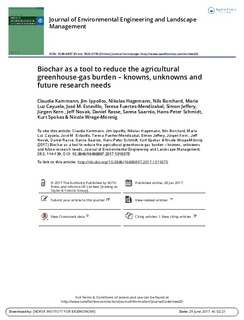| dc.contributor.author | Kammann, Claudia | |
| dc.contributor.author | Ippolito, Jim | |
| dc.contributor.author | Hagemann, Nikolas | |
| dc.contributor.author | Borchard, Nils | |
| dc.contributor.author | Cayuela, Maria Luz | |
| dc.contributor.author | Estavillo, José M. | |
| dc.contributor.author | Fuertes-Mendizabal, Teresa | |
| dc.contributor.author | Jeffery, Simon | |
| dc.contributor.author | Kern, Jürgen | |
| dc.contributor.author | Novak, Jeff | |
| dc.contributor.author | Rasse, Daniel | |
| dc.contributor.author | Saarnio, Sanna | |
| dc.contributor.author | Schmidt, Hans-Peter | |
| dc.contributor.author | Spokas, Kurt | |
| dc.contributor.author | Wrage-Mönnig, Nicole | |
| dc.date.accessioned | 2017-07-05T08:15:34Z | |
| dc.date.available | 2017-07-05T08:15:34Z | |
| dc.date.created | 2017-06-29T13:53:10Z | |
| dc.date.issued | 2017 | |
| dc.identifier.citation | Kammann, C., et al. (2017). "Biochar as a tool to reduce the agricultural greenhouse-gas burden – knowns, unknowns and future research needs." Journal of Environmental Engineering and Landscape Management 25(2): 114-139. | nb_NO |
| dc.identifier.issn | 1648-6897 | |
| dc.identifier.uri | http://hdl.handle.net/11250/2447846 | |
| dc.description.abstract | Agriculture and land use change has significantly increased atmospheric emissions of the non-CO2 green-house gases (GHG) nitrous oxide (N2O) and methane (CH4). Since human nutritional and bioenergy needs continue to increase, at a shrinking global land area for production, novel land management strategies are required that reduce the GHG footprint per unit of yield. Here we review the potential of biochar to reduce N2O and CH4 emissions from agricultural practices including potential mechanisms behind observed effects. Furthermore, we investigate alternative uses of biochar in agricultural land management that may significantly reduce the GHG-emissions-per-unit-of-product footprint, such as (i) pyrolysis of manures as hygienic alternative to direct soil application, (ii) using biochar as fertilizer carrier matrix for underfoot fertilization, biochar use (iii) as composting additive or (iv) as feed additive in animal husbandry or for manure treatment. We conclude that the largest future research needs lay in conducting life-cycle GHG assessments when using biochar as an on-farm management tool for nutrient-rich biomass waste streams. | nb_NO |
| dc.language.iso | eng | nb_NO |
| dc.publisher | Taylor & Francis | nb_NO |
| dc.title | Biochar as a tool to reduce the agricultural greenhouse-gas burden – knowns, unknowns and future research needs | nb_NO |
| dc.type | Journal article | nb_NO |
| dc.type | Peer reviewed | nb_NO |
| dc.description.version | publishedVersion | nb_NO |
| dc.rights.holder | © 2017 The Author(s) Published by VGTU Press and Informa UK Limited, [trading as Taylor & Francis Group]. | nb_NO |
| dc.source.pagenumber | 114-139 | nb_NO |
| dc.source.volume | 25 | nb_NO |
| dc.source.journal | Journal of Environmental Engineering and Landscape Management | nb_NO |
| dc.source.issue | 2 | nb_NO |
| dc.identifier.doi | 10.3846/16486897.2017.1319375 | |
| dc.identifier.cristin | 1479894 | |
| cristin.ispublished | true | |
| cristin.fulltext | original | |
| cristin.qualitycode | 1 | |
